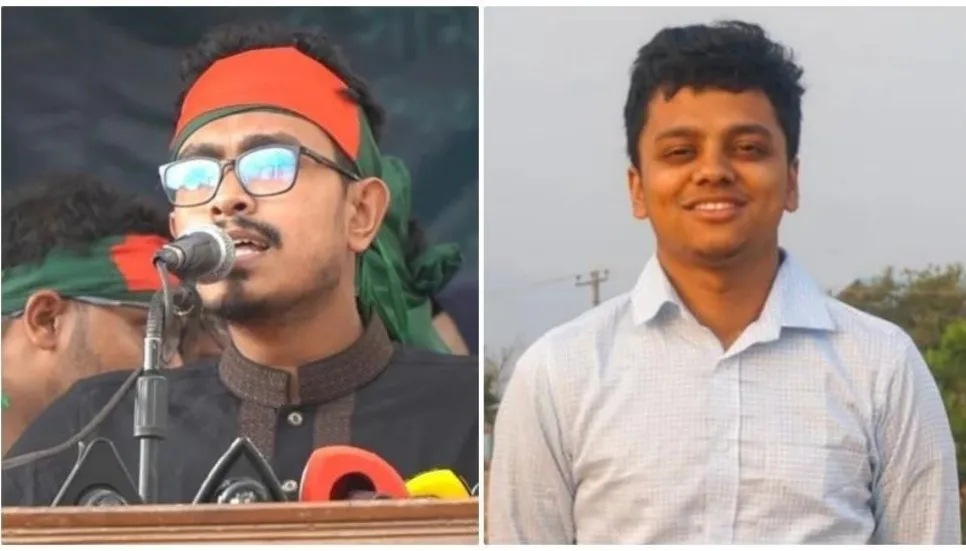
In a dramatic reveal, the top two leaders of Islamic Chhatra Shibir (Dhaka University unit), the student wing of Jamaat e Islami came to light for the first time.
President of the DU Chhatra Shibir is Md Abu Shadik Kayem, a student of the political science department of the Dhaka University of 2016-17 academic session. He has a meritorious background in DU academic life.
But he came into prominence as one of the faces of the July-August movement, part of the leading group just outside the six central coordinators.
SM Farhad has been revealed as the general secretary of DU Shibir. He recently completed his graduation from the Institute of Social welfare research. He is a student of the 2017-18 academic session of the university.
Mentioned, both leaders are from Chittagong Hill Tracts and studied at the same institution.
Abu Shadik hailed from Khagrachhari and he completed his secondary school certificate (Dakhil) from Khagrachhari Baitush Sharaf Madrasah, then he completed his higher secondary certification (Alim) from Chittagong Baitush Sharaf Jabbarja Adarsha Kamil Madrasah, and then he got admitted in Dhaka University and was a resident of Master Da Surja Sen hall.
This Abu Shadik played a significant role during the quota reform movement and anti-discrimination student movement. Even he played a significant role in the formation and circulation of nine points during the internet blackout.
He also managed to coordinate efforts to provide safe shelter to some of the coordinators who were still outside during the infamous Detective Branch episode, according to UK-based investigative journalist Zulkarnain Saer.
Accordingly, SM Farhad hails from Rangamati. He completed his Dakhil certification from Maini Bajtush Sharaf Madrasah, then he completed his Alim certification from Chittagong Baitush Sharaf Jabbarja, Adarsha Kamil Madrasah, and later took admission in Dhaka University.
According to Abdul Kader, another coordinator who was the main author of the “Nine Points,” SM Farhad played an important role during the movement bearing life risk. He clarified this through a Facebook post. This Farhad was an efficient debater of both in his Hall-Kabi Jashimuddin Hall-and in Dhaka University Debating society.
He was also president of the hall debating club. For his efficiency in debate, he was awarded by the then foreign minister Abdul Momen.
Both the Shibir leaders used to live in their halls, yet never raised suspicions, adding to the air of mystery gripping the nation. It played into stereotypes in the popular imagination of Shibir’s preference for stealth, and remarkable efficiency at it too.
As if to rub it in, the DU ICS president belongs to DU BCL President Mazharul Kabir’s hall and the DU ICS general secretary belongs to DU BCL GS Tanbir Hasan Saikat’s hall.
Asked about the political situation and the exposure of ICS leaders of Dhaka University, Tamzid Hossein said, “I see it as a positive change. In fact, they were among the most oppressed during the fascism period.
“Their democratic rights were taken away. In Bangladesh 2.0 we dream of a Bangladesh where everyone has the right to express their opinion, everyone has the opportunity to express their political position.”
Asked about political practice in the campus, he said, “It is definitely desirable that there will be student politics in the campus. Because one of the reasons why Awami fascism is prolonged is the lack of politics.
“In that case, the political parties have to come up with a new political policy in Bangladesh. The political parties should also take measures to remove the disrespect for politics that was created due to the terror politics of the Chhatra League.”
It may be mentioned, Islami Chhatra Shibir was banned on the Dhaka University campus by Poribesh Songshod. Although that wasn’t enforceable, their presence had progressively dwindled in DU campus politics over the course of AL’s 15- year regime.
“We who are alive in Shaheed-Gazi’s independent Bangladesh have a long way to go. To fulfill the dream of our martyrs, we should build a happy and prosperous Bangladesh unitedly. If we do not succeed, the blood of all the martyrs of ‘47, ‘71 and ‘24 will be wasted.
“The sight of our sightless brothers will go in vain, if we fail to build an independent and sovereign Bangladesh without discrimination,” Abu Shadik wrote on his Facebook timeline marking the success of the movement as a result of public participation.